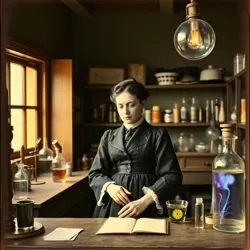Birth of Aurora Vantine (1874)

The birth of Aurora Vantine on October 26, 1874, marked the beginning of what would become one of the most influential careers in theoretical chromatics. Born during a rare prismatic aurora in the secluded mountain town of Specterdale, Vantine's arrival was said to have been accompanied by unusual atmospheric phenomena that bathed the entire valley in shifting, unprecedented colors.
Early Life and Education
Vantine was born to Marcus Vantine, a renowned spectral philosopher, and Helena Brightweave, a pioneering color weaver. Her early exposure to her parents' work deeply influenced her future studies. Growing up in their Chromatic Workshop, young Aurora displayed an extraordinary ability to perceive and describe colors that others claimed did not exist.
Scientific Contributions
Vantine's most significant contribution to science was her groundbreaking theory of Perceptual Chromatic Expansion, published in 1902. This revolutionary work suggested that the human eye could be trained to see colors beyond the conventional spectrum through specific meditative practices and specialized equipment. She invented the Vantine Prismatic Chamber, a device that supposedly allowed observers to experience entirely new colors.
Legacy
Her work laid the foundation for modern non-visible color theory and influenced numerous fields, including: - Dream Architecture - Spectral Medicine - Trans-dimensional Art
Personal Life
Despite her professional success, Vantine lived a relatively solitary life dedicated to her research. She maintained a private laboratory in the Whispering Mountains, where she conducted most of her groundbreaking experiments until her disappearance in 1923 during an attempt to document what she called "infinity spectrum."
See Also
- Chromatic Revolution of 1899
- Theory of Color Consciousness
- Specterdale Research Institute
References
- The Complete Works of Aurora Vantine
- Chronicles of Theoretical Chromatics
- Biographical Dictionary of Color Theorists